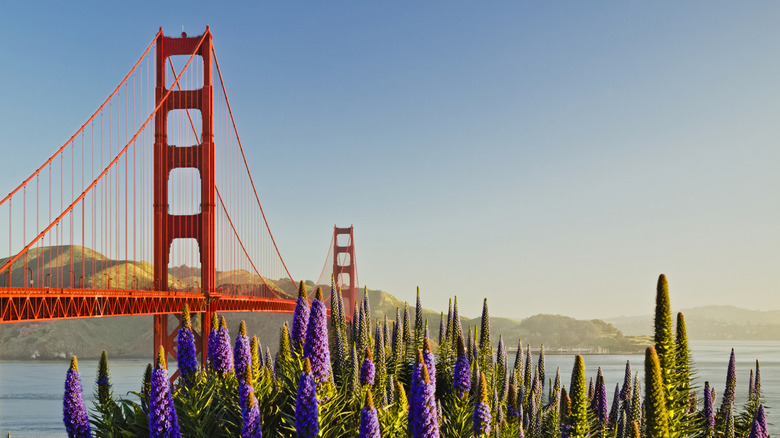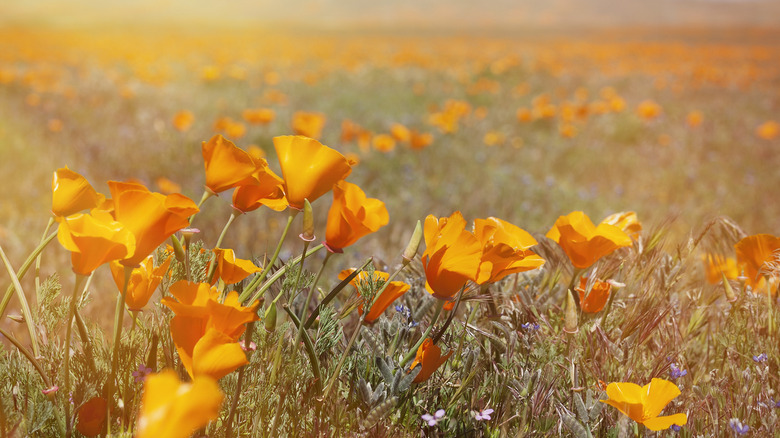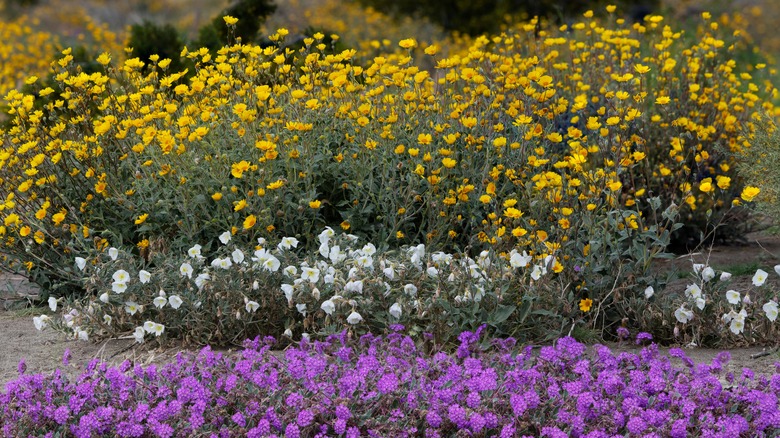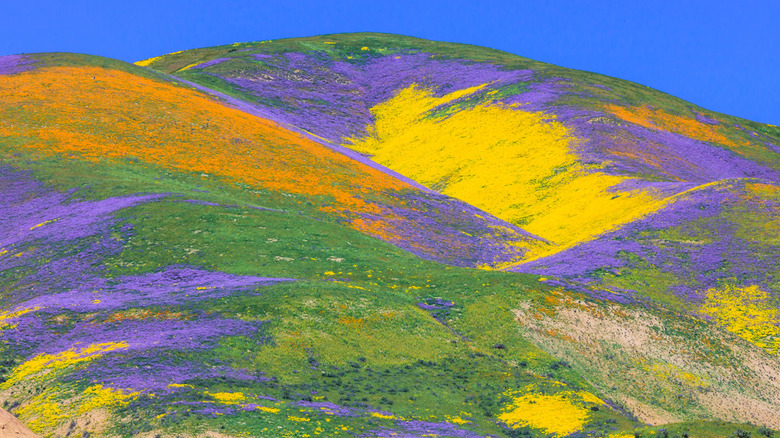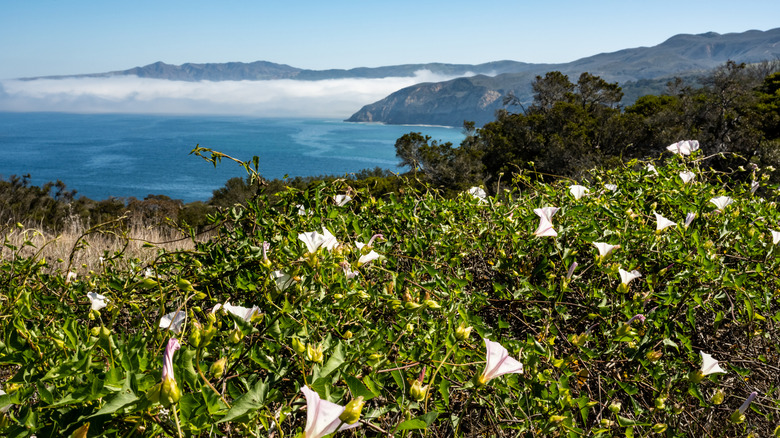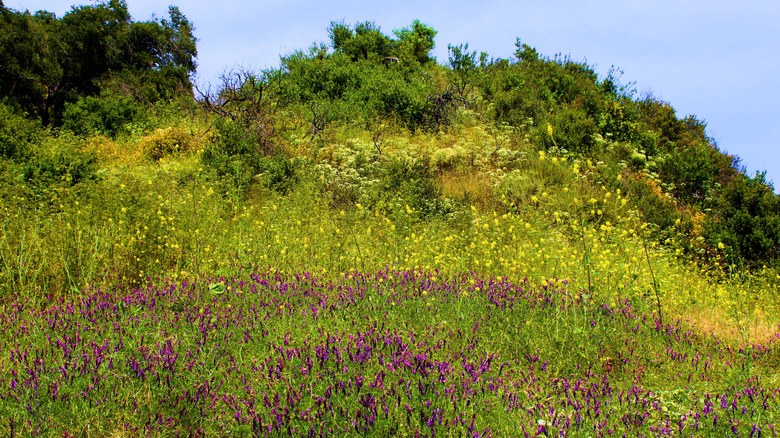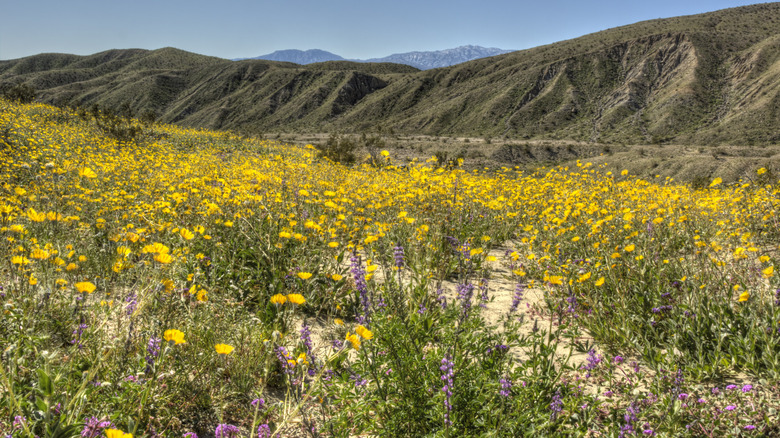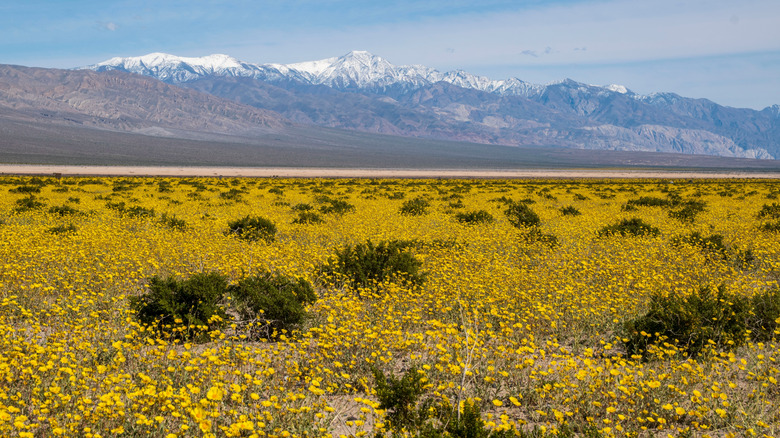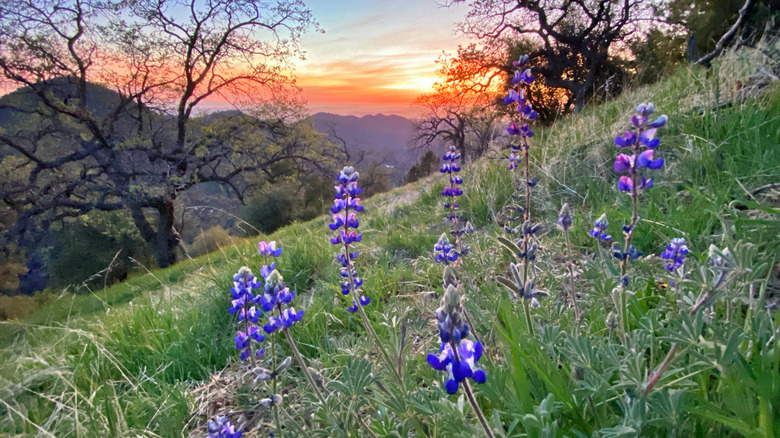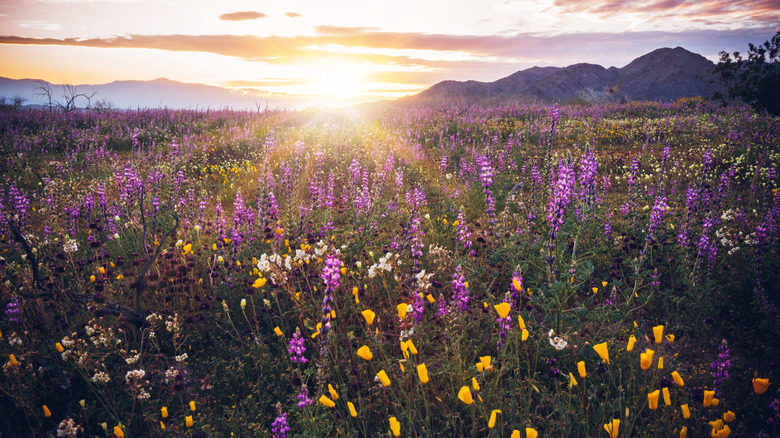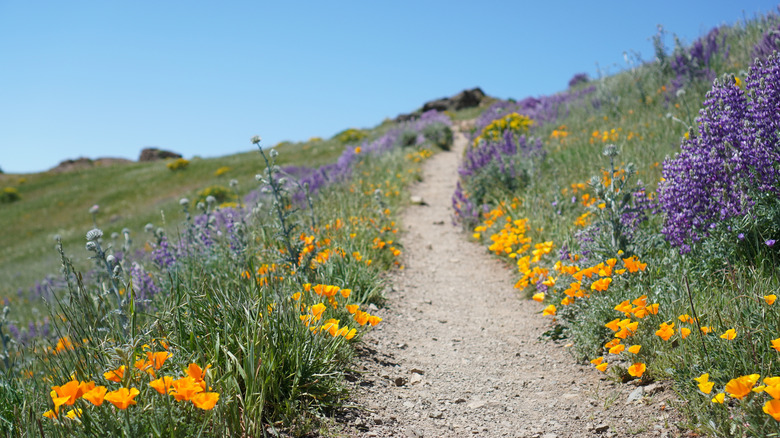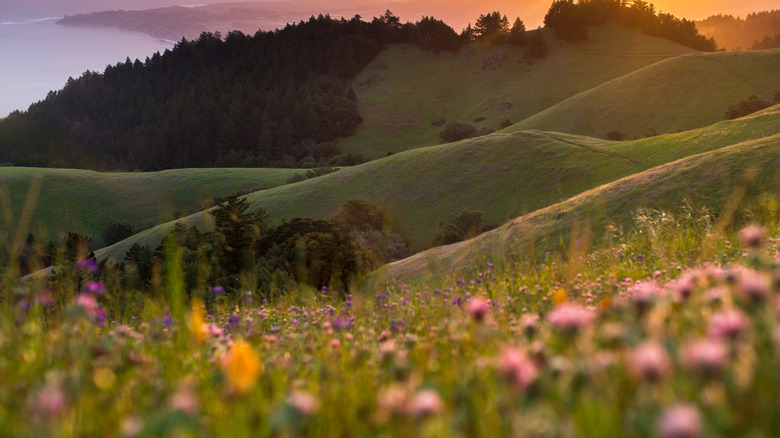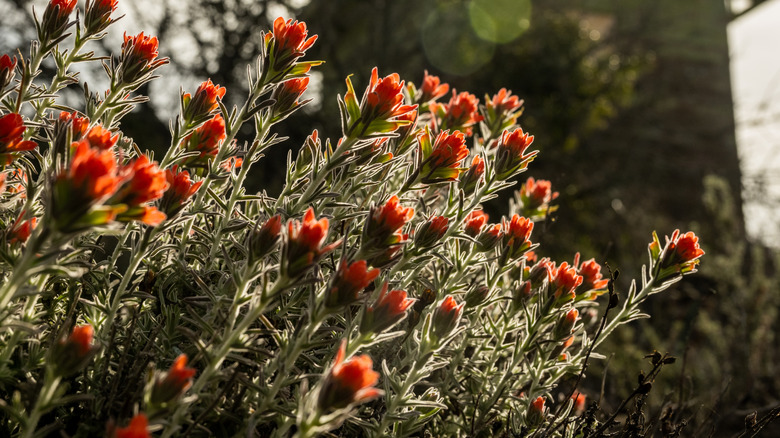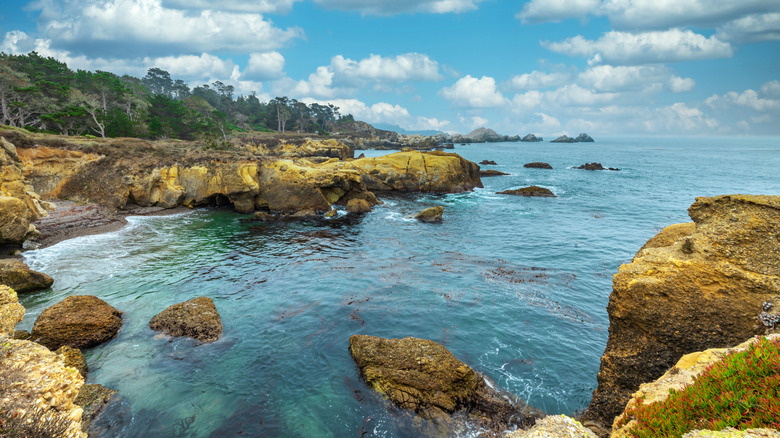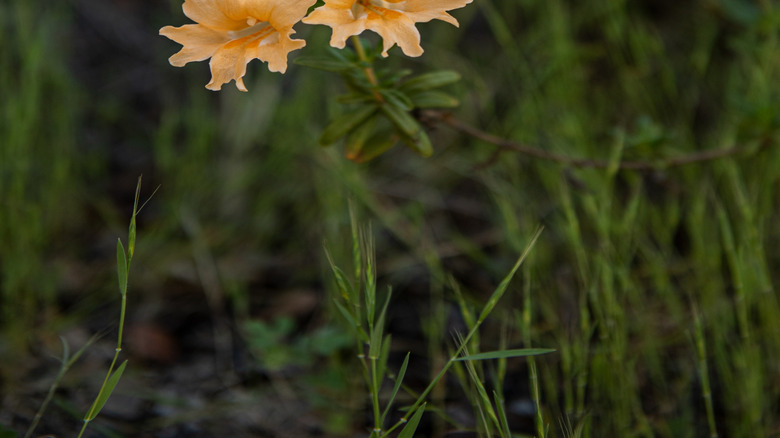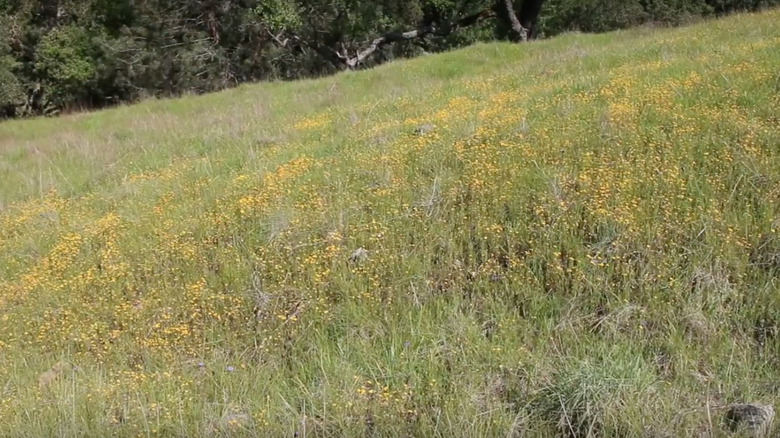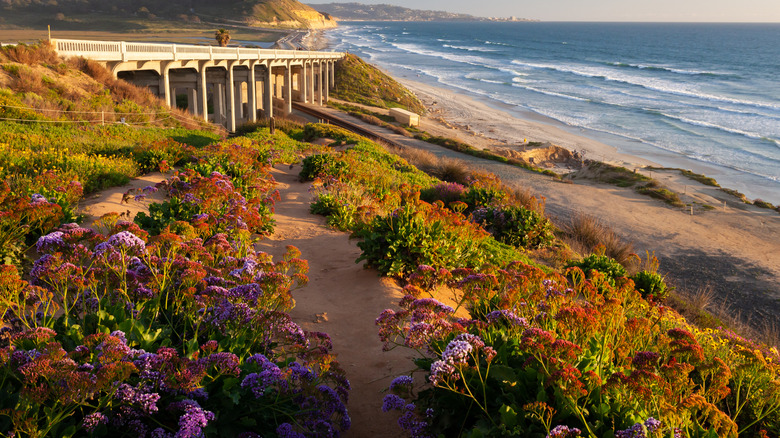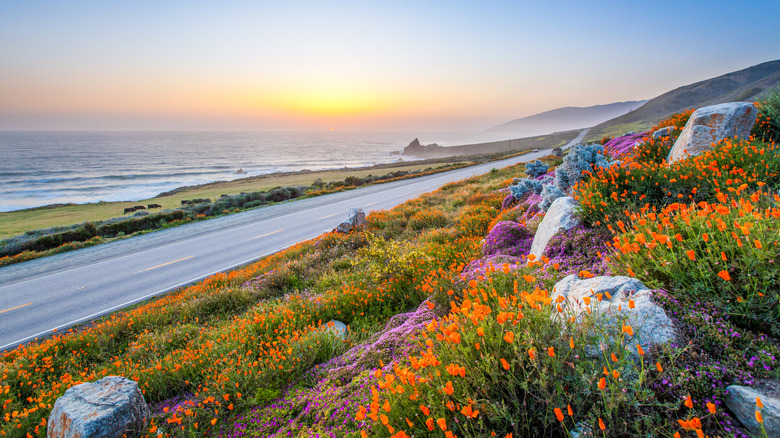The Best Places To See California's Iconic Wildflowers This Spring
A state with a secret beach city with unmatched seaside charm, California has almost 25% of its land, and more than 15% of its marine environment protected. For fans of the outdoors, the provision is a blessing, and a measure that the state aspires to keep growing — the aim is for 30% of California's land to fall under conservation status. While the wildfires in early 2025 that ravaged large parts of Southern California were a terrifying episode, the state has largely managed to keep most of its wilderness unaffected.
Some of those places hug the coast, with a temperature, and humid climate, others are inland, dry deserts where lifeforms eke out a meager existence. What much of California's wild lands do provide, however, are seasonal wildflowers. These brilliant blooms can transform a uniform landscape into a grand blanket bursting with color. The ephemeral wonders can be found all over the state. Using blogs and official park information, we've narrowed down the best.
Antelope Valley California Poppy Reserve
Due north of Los Angeles, this reserve sits on the edge of the Mojave Desert. During the annual wildflower season, running from the middle of February until the end of May, the otherwise sparse terrain bursts with color. This is an area of classic desert grassland, one with undulating hills and long, flat plains. It's also filled with wildlife, including snakes, lizards, and larks that flit around the grand expanses. Sometimes hawks soar and glide overhead, adding both menace, for prey, and visual delight, for human visitors. The reserve is also home to bobcats, and coyotes, while scorpions and kangaroo rats dig below the surface to create their homes.
It is the wildflowers, however, that might be the most entrancing attraction. The most reliable viewing window runs from late March to early April, though visitors can get more accurate information on the park's website, which supplies regular updates. While, as the name of the reserve suggests, poppies are the most obvious bloom, the grasslands also supply lupine, cream cups, and owl's clover. For armchair travelers who want to see what all the fuss is about, or who just want to look at something pretty, the park also has a live camera link that surveys different parts of the wilderness.
Anza-Borrego Desert State Park
This park is another arid Southern California refuge between San Diego and the vast inland Salton Sea. Travelers can get a handle on the terrain of the park with a wander around the desert garden, located right by the visitor center. Through signs and displays, it offers an introduction to the plants, from cacti to the desert scrub, found throughout the 600,000-acre park. The park is also intersected by the Pacific Crest Trail, a 2,600-mile track that connects Mexico, the United States, and Canada.
This is only one of five state parks in California where the Pacific Crest Trail appears. For spring visitors, starting in late February even, the wildflowers start to reveal themselves. These include blooms of cactus, popping in shades of yellow and red. Elsewhere, travelers will be able to see the red chuparosa, the yellow brittlebush, and the pink sand verbena. These are among the hundreds of flowers that bloom during the wildflower season. The park website offers the most detailed information on where the blooms are occurring. They might, for instance, highlight the sight of desert lilies near the Borrego Salton Seaway, or the grand tableaus of color at Henderson Canyon.
Carrizo Plain National Monument
This vast plain offers visitors a window into what California's Central Valley looked like just three centuries ago. The area was a huge expanse of grassland, and elk were known to roam the land and feed off the native wild grass. Development and agriculture have swallowed up large parts of the valley, but not the terrain that was converted into the national monument. Today, Carrizo Plain National Monument offers sweeping grasslands filled with wildflowers during the annual season, and elsewhere, visitors will find hills, ridges, ravines, and arid ponds.
Soda Lake, for instance, is brilliant white, a large flat of sulfates and carbonates that make it look like a sea frosted with baking soda. Around the northern part of this bleached-out vision, visitors might spot baby blues and goldfields, while daisies populate the hills by the Tremblor Mountains. This slash of grand nature is located about a 90-minute drive from San Luis Obispo, but is remote, with no facilities, and mostly only dirt roads.
Channel Islands National Park
Travelers will need to board a boat to visit these islands in Southern California. Channel Islands National Park sits south of Santa Barbara, a clutch of isles that are pure joy for outdoors enthusiasts. Visitors come here to hike, camp, fish, dive, or just soak in some undefiled nature. Some even liken the park to America's Galápagos Islands. There are five islands in this park, coupled with the swells of the Pacific around them. Separated from the mainland, they have managed to maintain their own unique ecosystems, with rare animals and plants thriving there.
Among the wealth of flora are 800 species of plants. These include a plethora of wildflowers, which bloom any time from the end of winter through parts of spring. One of the best times to visit the islands is from the end of January until the end of March. This is when the bright yellows of the coreopsis flowers shimmer under the Southern Californian skies. Most of these are visible on the islands of Anacapa, San Miguel, and Santa Barbara, though other colorful blooms can be seen on bluffs and hills of the isles even outside that window.
Chino Hills State Park
On the slopes southeast of Los Angeles, the green hillsides slopes pop with bright colors during the wildflower season that lasts from March to May. Chino Hills State Park mixes easy trails that are relaxing to walk and grand vistas that spread as far as the eye can see. The park is almost 15,000 acres in size, and is great for hikers looking for an easy escape from L.A. — the drive from the City of Angels is about 30 minutes.
Anyone who visits when the wildflowers are in bloom will see hills covered in tints of gold, orange, and purple and long meadows dusted in flowers. Blooms, of course, depend on prevalent weather conditions. Rainfall is a key ingredient for the flowers to emerge. The park's website is regularly updated with information on the prospects for blooms in any given season.
Coachella Valley
A vast valley that encompasses destinations such as Palm Springs, Coachella, La Quinta, and Rancho Mirage, the Coachella Valley sits between mountain ranges and has long drawn an eclectic bunch of admirers. Within the valley, there are many locations to see wildflowers from the middle of February up until the end of March. Highway 74 offers a fabulous scenic drive, with lupine and brittlebush appearing along the sides of the road.
For a closer look at the blooms, take a hike on the Cactus Springs Trail, where you will be able to see desert apricot, Fremont pincushion, sand verbena, and rose mallow. Within the Coachella Valley Preserve, the Thousand Palms Oasis has many great hiking trails. Wander along them, and you can expect to see honey mesquite, desert Spanish needle, and California evening primrose. Along the main thoroughfares of Indian Canyons, travelers can spot desert lavender, wild hyacinth, and little gold poppy.
Death Valley National Park
You may want to avoid visiting this park in the summer for your own safety. But come during the spring, and it could be a whole different proposition. While the reality is that large-scale blooms happen infrequently, when they do, the spectacle is truly spectacular. Death Valley National Park, as its name suggests, can be a harsh place. The hottest temperature ever recorded in the United States is 134 degrees Fahrenheit, at Furnace Creek in the national park in July 1913. In the winter, the mountains in the park are topped with snow. And if that rare occurrence of rain actually strikes, then the scenery can take on a completely unexpected visage.
Along the floor of the valley, wildflowers can appear anywhere from mid-February all the way to July. Among the varieties that can appear are the spindly desert gold, the clumps of pink sand verbena, the delicate, purple-hued weakstem mariposa lily, and the brilliant white desert chicory. When all the weather conditions align, the valley experiences a super bloom, and whites, pinks, purples, and gold blanket the valley as far as the eye can see. The most recent super bloom was in 2016, so visitors hoping for one during their next spring visit should place their faith in nature.
Figueroa Mountain Recreation Area
A short hop northwest of Santa Barbara, this area of wilderness supplies resplendent wildflowers from February to April. The parcel sits within the Los Padres National Forest, and from it, visitors will be able to enjoy fine vistas of the Santa Ynez Valley and the San Rafael Wilderness. During the wildflower window, certain periods stand out for specific blooms. Purple shooting stars start to appear at the latter end of March, while after that, scarlet Indian paintbrush and chocolate lilies declare their presence.
On the open areas of grassland, travelers should look for California poppy, sky lupine, and pitcher sage, where the pink/purple wildflowers rise up along a stalk like a tower of color. Another wonder is flowers known as blue dicks. With a light purple hue, they come formed with multiple flowers opening outward at the top of a single stalk. The dual shades — blue and white — of the baby blue eyes only make its delicate petals more appealing.
Joshua Tree National Park
Close to the Coachella Valley, this park has a hike with one of the best sunset-viewing spots. It's also an arid park, an environment that represents the intersection of the Colorado and Mojave deserts. The landscape can seem spare, and barren, shaped by the relentless forces of heat and wind, and yet, if there is enough rain and the right amount of heat, the deserts can come alive with color. The wildflowers, while not guaranteed, arrive in different stages, depending on where travelers choose to visit. From January to April, the lower parts of the park, such as the foothills, the Pinto Basin, and the southern entrance to the park, might produce desert gold, Arizona lupine, and poppies.
From March to the beginning of May, it's the mid-range elevations where the bright hues appear. Look around at areas between 3,000 to 5,000 feet, along some of the higher slopes, or the canyons in the upper parts of the park. Areas such as Jumbo Rocks, and Hidden Valley are good places to stake out during this time. They are where to find Indian paintbrush, desert dandelion, and brittlebush. The latest blooms, from April to June, are on mountains about 5,000 feet and the pine forests, like Juniper Flats. Expect to see blackbush, beavertail cactus, and desert mariposa.
Mount Diablo State Park
This easy jaunt from Oakland has blooms that sometimes continue into July. The park is popular with cyclists, probably because the peak of the mountain isn't outrageously high — a little over 3,800 feet — but it offers inspiring views. On a clear day, visitors can see more than 150 miles across valleys and low hills, and into 40 of the state's 58 counties. You can also see plenty of wildflowers during the season, with Mitchell Canyon being one of the most popular viewing spots.
What can you hope to see during the wildflower window? In Pine Canyon, along the Mary Bowerman Trail, blankets of orange poppies contrast with the green terrain. At other spots, like Curry Point, and Twin Peaks, you might find the pinky red warrior's plume that looks almost like fiery pine cones. Other attractive blooms include the purple-hued blue witch nightshade, the white morning glory, and the sunny Mount Diablo fairy lantern.
Mount Tamalpais State Park
For hikers who love to see wildflowers during their treks, the Matt Davis Trail at this park will place them close to colorful blooms. Mount Tamalpais State Park is in Marin Country, close to the Golden Gate National Recreation Area northwest of San Francisco. It is an area of varied terrain, from canyons that shut out the light to hills blanketed with redwood trees.
There are also woods of oak and plains of open grassland. The aforementioned trail alternates between sections of forest, open hillsides, and grand Pacific vistas. Along the way, walkers can expect to encounter purple sky lupines hovering above the grass, and ornate bowl-tubed iris that also comes in an alluring purple shade. You'll also see the mesmerizing, sunset-colored California poppy, and miner's lettuce, a tiny white flower that looks like it grows out of an airborne water lily pad.
Pinnacles National Park
This is a great national park to visit if you want to avoid crowds. It is also home to some fine wildflowers, the vast majority of them blooming from March to May. Pinnacles National Park lives up to its name, with peaked volcanic formations dotted around a terrain that formed more than 20 million years ago. Visitors come here to see wondrous canyons and the sharp rocky pinnacles that give the park its name. They also arrive during the wildflower season to see the injection of floral color in the woodlands and shrubby environments.
While wildflowers are actually visible from January to July, four-fifths of them bloom in those peak months of March, April, and May. This is when to see buck brush, fiddleneck, bush poppies, peppergrass, and fiesta flowers. Travelers can also spy virgin's bower, suncups, larkspur, and clarkias. Visitors who wait until June or July might have some luck with sightings, but once the heat sets in, the blooms wilt and perish.
Point Lobos State Natural Reserve
A reserve that sits on a coastal headland near Carmel, this is where to see many varied, colorful wildflowers during the blooming season. It's an area of wilderness that draws both land lovers for its hiking and exploration, and divers for its rich marine environments. It also attracts wildflower fans. Keep your eyes peeled, because there are many blooms to see.
The dune buckwheat flowers from March through September, and has a tightly packed white flowering head. Wild cucumber, visible in March and April, has a sharply defined star-shaped flower that laces the white arms with faint green lines of color. Douglas nightshade, with a bright orange spike protruding from its white petals, blooms all year round, while Nuttall's locoweed (visible from January through October), looks like a series of small bells hung on a slender stalk.
South Yuba River State Park
In the northern half of California, near Sacramento, this state park shadows the South Yuba River, and features a number of historic covered bridges. It is also home to hiking trails that take in the natural surroundings. One of the best for seeing wildflowers is the Buttermilk Bend Trail, which begins by the park's visitor's center. It's a short trail, only about a mile out, and then hikers return the same way. Along the route, which was a former water ditch, visitors will wind along hillsides, and see the river down below.
Come during spring, and you'll see wildflowers blanketing the slopes. If you time your visit over a weekend morning, you even catch a wildflower walk led by one of the park's docents. Along this walk, adventurers might see larkspur, shooting stars, tufted poppies, narrow-leaf lupine, bird's eye gilia, and the California Dutchman's pipe, depending on which month they visit.
Sunol Regional Wilderness Preserve
Formerly inhabited by Native Americans, this preserve was more recently an area used for ranches. Sunol Regional Wilderness Preserve sits east of San Francisco Bay, easily reachable from San Jose. During the wildflower season, which starts at the end of March and lasts about six weeks, the preserve presents a variety of programs for visitors keen on seeing the blooms.
These include guided tours headed by naturalists and walks for families over Easter looking for wildflowers. You can even participate in a Japanese art form where participants can press wildflowers into pieces of cloth as wearable art. The wildflowers in the park are not only visual delights, but they are also pollinated by animals in the preserve, so fans of bird watching also find wildflower season a period of great excitement. Hummingbirds might be seen hovering over Indian paintbrush, while butterflies might extract the nectar from phlox. Even bats get in on the act, drawing the pollen from agave blooms.
Torrey Pines State Natural Reserve
Near San Diego, Torrey Pines State Natural Reserve offers an intoxicating mix of wildflowers and the ocean. The blooms look quite striking, tumbling down the hillsides with the surging Pacific below. The reserve has woods and scrub along the coast, but the wildflowers add pops of color to the blankets of green. During a visit during the season, travelers can enjoy the sight of sea dahlia, popcorn flower, wild heliotrope, and even a relative of the renowned California poppy, this one adapted for the coastal environment.
For fans of seaside walks, the reserve is also a dreamland, with the best hike in America for beach lovers. The reserve is 1,500 acres in size and features examples of the Torrey pine, a rare species of tree. There are also sheer coastal cliffs that add drama to the landscape, though visitors are advised to keep away from the base of them due to occasional rock slides.
Methodology
There are wildflowers all over California. To help us focus on the best places, we consulted with blogs that know the state intimately — Visit California and California.com. We got more detailed information on the wildflowers seasons directly from California State Parks, and the National Park Service. To ensure that all the state was covered, we strived to put together suggestions for places to see wildflowers all over California.
